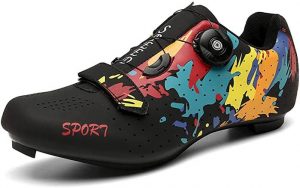Quick Navigation
Introduction
The pairs of cycling shoes available in the market and their differences are stunning. However, your cycling shoes must fit well when it comes to using and purchasing them. Positioning the right cleats on your shoe can go awful on your foot, and the wrong positioning of the cleat impacts the foot’s loading on the power stroke, making it a wasted effort. What’s more, finding the cycling shoes doesn’t mean that you are only seeking the right fit for your foot, but having the right fit commensurate with your cleats and pedal.
Before you purchase that cycling shoes, ensure you follow these guides so that your cycling shoes will function well with your bikes; while receiving the most out of your rides.
Also read about the ideal shoes for hiking.
Meaning of Cycling Shoes
A cycling shoe is a shoe made to be worn during cycling. It is a shoe specifically designed with a unique sole where a cleat can be attached. The dominant features of cycling shoes are rigidity (because of effective power transfer from the cyclist to the pedals), adaptability (because of bicycle use, off and on), and weight (a measure of placing the shoe comfortably to the pedal).
How Should Cycling Shoes Fit
The Shoe Width
The widest foot part is the front that has the balls of the foot. Some have splayed toes and the widest part in the front. The area is where there is contact between pedal and foot and where the pressure is applied to power on the pedals. If you noticed untoward tensions in your foot, you got the wrong shoes. There needn’t be any space on the sides. A movement along the feet sidewards can cause injury.
The Shoe Length
Unlike in jogging shoes or trainers, the front’s added space is a big no for cycling shoes. It is okay with the running shoes due to the natural foot motion will abut the shoe front. With cycling or spinning, the foot shouldn’t be subjected to a lot of rolling action. Small freedom of foot cramping is permitted; a small millimeter from the big toe to the insole first part should suffice.
When you fit out your cycling shoes, match them to the insole to determine where the ends will fall. Endeavor to push your foot backward to position the heel in complete contact with the end of the shoe and find how much room is left between the foot front end and the shoe front.
The Firm Hold
A firm fit or hold in the heel place is what an ideal shoe should provide. Two major easy tests will show how well the cycling shoe should suit. Firstly, the shoes shouldn’t slip out when walking with them. Second, the shoes shouldn’t cause discomfort or pinch. No heel movement shows the right seating; the shoe is made to sit firmly on the foot’s back. The shoe upper should comfortably and firmly enclose the foot there. More so, cycling shoes should feel snug and firm when you wear them. When you wear big shoes, miniature contacts cause pressure points on your foot, hot spots, and heel slip.
Read a comprehensive article on how to find a shoe that fits.
The Sound Closure
The shoe locking system demands a great deal of attention. For a good reason, it affects every difference of a great-cosseted foot, specifically on the pull stroke, by offering the needed support. Velcro and buckles are not required to press no matter what. Provided that twist fasteners move, the deflection points of ideal stability should be stationed rightly. If there is a rise of wrinkles when your shoe is fastened and closed, it is an indication that your cycling shoes aren’t an excellent fit.
The Firm Upper Material and Stiff Soles
A common rule states that the stiffer the sole, the better the sole. This rule is applicable for performance and comfort. Your foot is inured and stable from tiring. The upper material is a bit different. It holds it stiff at transmission points of power and also pads the foot’s sensitive parts.
The Quality Insole
A pair of cycling shoes have a factory-fitted footbed or insole. While this feature fulfills the fundamental duty of cushioning, the biomechanical factor is set aside. The factory-fitted footbed or insoles are wafer-thin and don’t have other factors into consideration. You should change it to something like tailor-made for a particular forefoot and arch. Expert firms design excellent insoles, and it will be an extra but worthy cost. Some cycling shoes have fair insoles that could be placed to use as customized with diverse thickness wedges that could be velcroed or inserted into the footbed.
The Heel Support
Your cycling shoe heel part needs to be firm and snug-fitting without pinching you. Your shoe back end need to wholly support the heel and prevent it from going around a lot. This support is vital to avoid injuries when spinning or cycling.
How Tight Should My Cycling Shoes Be
As hinted, a pair of cycling shoes that is fitted needs to be tight and near-fitting without putting the instep to unrestrained pressure. Your shoe should equally have a toe room or slight give at the end to not tweak or nip the toe or restrain the toe movement.
Finally, it is vital to add that cycling shoes aim to have your forefoot stable and push the needed power when you want to pedal hard. Thus, it goes down to the right balance of wiggle room and tightness.
Conclusion
Cycling shoes are crafted not to work for an extended period. Thus, when fitting your shoes, they must be comfortable and firm from the beginning and hold your foot like a glove without compression.
Some shoes are wider or longer than others. And the first way to know if they are excellent and fitted is to put them on before selecting.

